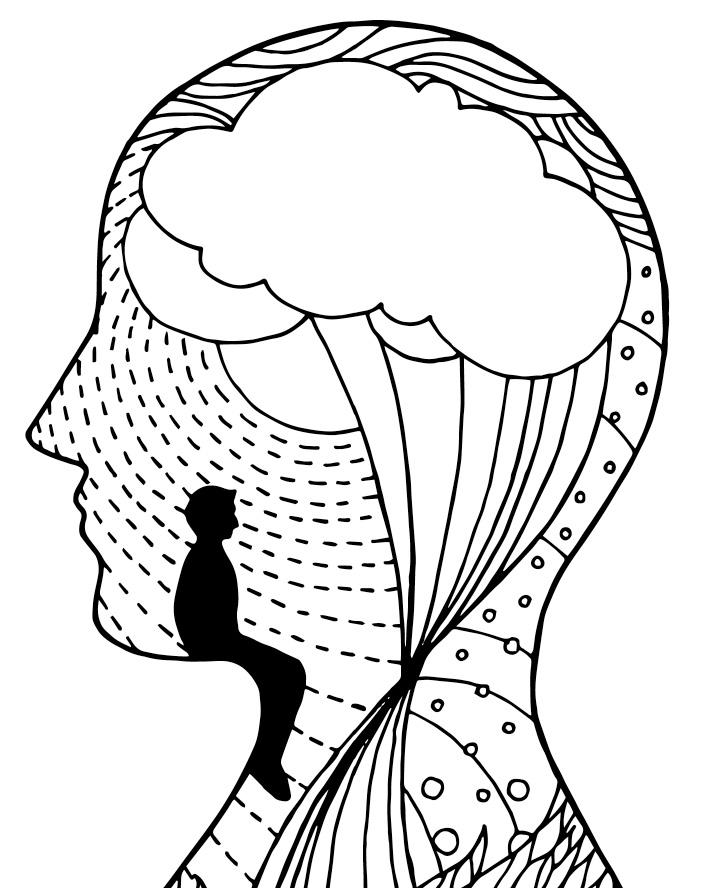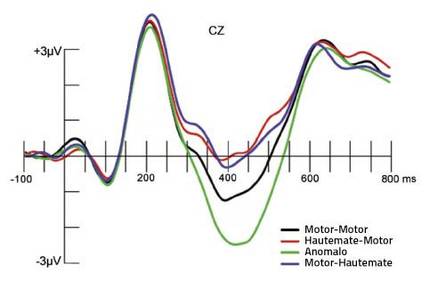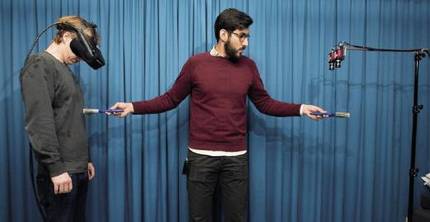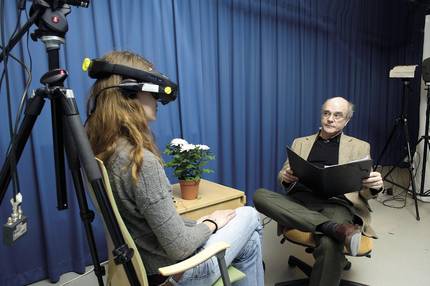We are also body
2017/12/01 Galarraga Aiestaran, Ana - Elhuyar Zientzia Iturria: Elhuyar aldizkaria

In the day to day we use expressions that demonstrate a close relationship between language and body. For example, we tend to place the morally good up, and the bad or bad down. When we are in good mood, joy overflows us and we want to keep the roof; when we are sad, we are sunk, in danger of sinking. We imagine the future ahead and the past behind. We feel small before someone we admire, big in front of what we dominate.
This type of metaphors show that we consider our body as the center when talking about abstract emotions and concepts. Thought and language are not only mental activities; the body also participates in these cognitive processes. In fact, in recent years neuroscientists are studying to what extent and how the body influences these cases.
Action and Word
They are known, for example, experiments that demonstrate the compatibility effect of the action and phrase. In one of them, volunteers were asked to draw a lever, once the meaning of the phrase given by the researchers was understood. For if the lever phrase they attracted before was proper (“Liz has told you a story”) that when it was in the opposite direction (“You have told the story Lizi”). With this second sentence, the volunteers showed a contrary trend, that is, they tended to remove the lever, so they needed more time to understand the phrase and attract the lever than when the direction of the phrase was according to the action.
The effect of compatibility of the action and phrase has also been demonstrated through neurofiguration. They already knew that when listening to a phrase that explains an action, the brain activates not only spaces related to the understanding of language, but also those related to action. In 2013, a step further, they measured the compatibility effect. The volunteers measured the potentials related to the action by placing electrodes and saw that in these potentials a special wave appears when the phrase and action do not match. This wave, called N400, does not appear when the phrase and action are compatible.
From actions to emotions
Perhaps it is not so surprising that the body influences the understanding of the phrases related to actions. In short, we perform these actions with the body. What happens to emotion-related phrases? Does the body influence your understanding? The answer is affirmative.

To demonstrate this, three researchers (Havas, Glenberg and Pitk) conducted a simple experiment with a pencil. The volunteers had to keep the pencil horizontally or vertically with the mouth. Placing the pencil in horizontal, they achieved a gesture similar to a smile, and in vertical a sad gesture.
With the pen in the mouth in one way or another, they had to read phrases with emotional content. And they showed that the volunteers read and understood the phrase faster when the emotion I explained was consistent with the gesture of the face.
The researchers related the result with mirror neurons. In fact, empathy is based on the system of mirror neurons that, by imitating the emotional gestures of the face, activate in the brain zones related to emotion.
Another significant example of the relationship between gestures and meanings was the one that the authors mentioned in the pencil research: other researchers showed that the volunteers understood the word “love” more easily if they requested that the arms be reunited while the arms were extended. And vice versa: they understood more easily the word “hatred” with outstretched arms than when they were picked up.
With the pencil the same thing: they read and understood faster “the President of the Faculty has said your name and you have proudly climbed to the tablado” when they had the pencil in the horizontal mouth, that if not, and the opposite occurred to them with the following sentence: “The police car goes behind you, at full speed and hitting the siren.”
Botox, an emotional impediment
Previous experiments show that the body is fundamental to understanding emotions and thoughts. So, what would happen if I did not allow to express emotions physically? To prove this, Havas and his team used the button set in a study conducted in 2010. The title of the research says: The cosmetic use of botulinum toxin affects the processing of emotional language.
The participants were 41 women who were performing a cosmetic treatment. All of them injected the button set into the muscle that causes eye contraction to smooth the wrinkles of the forehead. Therefore, they could not deny the front.

The researchers had them read a series of sentences, two weeks before and two weeks after the injection of botox (time of greater influence of botox), and the women had to press a button, once understood the meaning of the phrase. These phrases showed anger, joy and sadness.
As expected, the results of the experiment showed that the expression of emotion with the face is essential to understand in the first blow phrases of emotional content. The women, after injecting the button set, needed more time to understand phrases than before, especially those that had a sad meaning.
From this experiment, the researchers concluded that there is a direct interaction between the body and emotional language in processing. In addition, this interaction is bidirectional, that is, words generate emotions that affect cognitive processes. This is very clear, for example, in the spirits that are given to athletes, which is the aim of the words of encouragement of coaches and amateurs.
The body, the key of memory
However, the influence of the body is not limited to language. Neuroscientist Loretxu Bergouignan, for example, now works at BCBL in a language-related research, but has previously worked at the Karolinska Institute in Stockholm, investigating the influence of the body on memory.
He realized the need to open this field when he was performing the thesis. The aim of the thesis was to investigate the influence of stress accumulated in the memory of experiences and in the brain. He explained that people with posttraumatic stress, even those with depression, have seen the episodic memory related to their life destroyed, a type of memory that reminds us as if we were to live the events of the past. “Memory of memories, that is, episodic autobiographical memory”, says Bergouignan. “While I was investigating with them, I saw that the hippocampus was involved there.”
This seemed particularly interesting to him. “For a long time I’ve been trying to understand what happens when torture or traumatic experiences like this, how we integrate that experience and how it affects.” He noticed the importance of hippocampus in psychopathologies (depression, post-traumatic syndrome) that are derived from serious experiences.
The next step was to analyze what happened in people with accumulated trauma but without psychopathology. Thus, she investigated healthy women who had passed breast cancer. There were sixteen women, all of them with breast cancer, but who responded well to treatment, healthy and without alterations due to accumulated stress, neither post-traumatic stress nor depression. Another 21 women without cancer also participated as control.
The study found that cancer superchargers had a lower hippocampus than other women, with an average volume loss of 8%. In turn, they had less capacity than those of control to remember negative autobiographical experiences (20% less). In any case, both groups remembered better the positive experiences than the bad ones.
In Bergouignan’s words, “that means reducing the hippocampus is not a consequence of a psychopathology; in the accumulated stress there is something that moves the memory system. Living one’s own stress and, where appropriate, the means we use to respond to it.”
Hence the following question arose: to see if the body participates in it. “After all, we have the corked memories, but that is not yet investigated. In the clinic we do know, the greater the dissociation, the greater the posttraumatic stress, but when there is no disease outside the clinic it is not investigated. That’s what I wanted to see: what relationship exists between body and memory, what function the body has as a filter.”
In fact, dissociation is the separation or discontinuity between thought, memory and self or autobiography, and in other cases, for example, in which there is an alteration in the limit of personality.
Outside the body
To analyze the function of the body as a filter, he designed an experiment that placed the person outside the body. In these experiments they use virtual reality techniques to make the person who is out of his body feel. To do this, they put some glasses at the disposal of the person that allow him to recognize himself in an environment. Then they touch the body with a stick. At the same time, it is touched with sticks. Thus, with visual and tactile synchrony, your brain interprets that your body is what you see, that is, it is outside your body.
Bergouignan used this method to see if the experiences are integrated in the same way when one is in his body and is out of him.

He has specified that the situation to remember was also controlled, that is, he created it expressly in the laboratory: “If not, we are always analyzing what the person remembers from a fact that has occurred in the past, but without knowing the event. In the experiment everything was created by us. An actor did a kind of analysis to the volunteer following a script. He played the role of a very peculiar teacher and created real experiences. So, I knew what happened and then, through questions, I could see how far volunteers remember what happened.”
The volunteers did this false study being inside and outside their body and a week later they had to count on as much detail as possible as they remembered about it. “We wanted to know if they remembered the details, that is, if they lived the event again (the episodic memory); or they knew what happened, but they did not remember the context (the semantic memory); or they did not know or remember.”
Episodic and semantic memory
To distinguish between episodic and semantic memory, Bergouignan offers an example. “In our autobiographical memory we have semantic and episodic elements. So, you already know what your name is, but do not remember the first time you were called by that name. That is a semantic knowledge. On the contrary, if remembering something that has happened comes back to life, with emotions, that is an episode and a completely dependent hippocampus.”
In that experiment they realized that the lived from outside was semantized. They had many more episodes, if they lived from within. “This from the point of view of behavior. In addition, we analyzed another group by scanner. Our hypothesis was to introduce information into the hippocampus when you are out of the body blocking.”
In fact, he explained that the hippocampus acts as an association and connects the brain zones to create coherence. Therefore, being out of the body, these connections would not occur. “Because the scanner showed that the only space that changed was that just, the hippocampus, and specifically the same part of the hippocampus that is reduced in post-traumatic stress, depression and cumulative stress without psychopathology.”
Bergouignan confessed that when he saw this image “he was surprised”, either out of the body or inside, because that part of the hippocampus was the only one that changed. “This does not happen many times,” he said. “In fact, there are many spaces involved in a system that has to do with our being and all are related to the hippocampus when remembering personal facts. But the difference was only in that specific part.”
He says research was a “starting point” to understand what was going on between body and memory, “but it’s just the beginning.”

Intrusive memories
On the other hand, he explained that the hippocampus is very active in remembering something for the first time, “remembering for the second time has less activity and the third, the fourth, less and less. We already knew that. So we look at what happens to repetition. That was the question.”
And the answer is: “Quite the opposite if you live the event from outside or inside. When you live from the outside, for the first time there is no activity in the hippocampus, but with repetitions it is activated. It seems that in the hippocampus the memory system constantly seeks a coherence. Perhaps, and this is another hypothesis, the activation with repetitions is ideal of what happens in intrusive memories. Those intrusive memories are those that come to you suddenly and without your choice, and maybe they come because the information has not entered cohesion and the system tries to integrate them constantly.”
Therefore, Bergouignan considers that the explanation is: “Being out of the body all spaces related to your being are activated, except the hippocampus. Therefore, the information is not related. It is a hypothesis: at first, to remember it when you ask, there is nothing related, so the hippocampus is not activated, but then, how it always seeks something coherent, it tries to unite the elements of the situation. Hence the intrusive memories. That is the hypothesis that we have reached the conclusion that with repetitions the hippocampus is activated.”
Escape to the detriment
According to Bergouignan, there are still many things to prove. For example, to relieve the traumas of those who have suffered such violent torture, rapes and experiences, there are therapies related to the body, but their circumstances have not been scientifically demonstrated.
However, it has a hypothesis. In the words of Bergouignan, when these situations occur, dissociation of the body is considered an adaptation that is believed to benefit. “We have shown that this prejudice is false because we have shown that adaptation is a bad length. Therefore, there are those who will use dissociation as a strategy; they will think that this is not part of my life, I am not here. But we should act just the other way around and, even in difficulty, be as present as possible. Because running away will hurt.”

Gai honi buruzko eduki gehiago
Elhuyarrek garatutako teknologia







